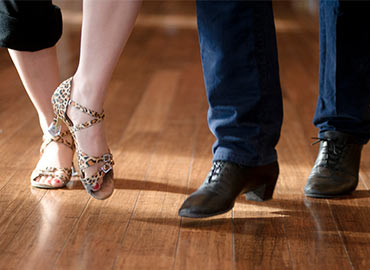WHY Do We Use Rise and Fall in our Dance Movement?

Last time, we discussed the importance of toe and heel leads in our ballroom dance movement, but we never talked about an important part of the latter: The raising and lowering of the body known as rise and fall. So, WHY is rise and fall such an important part of most smooth/standard dances?
It’s helpful to remember that ballroom dance movement generally exaggerates movement that we do every day. We actually use rise and fall simply by walking normally: The body dips slightly as we step out with one foot, then rises as it passes over top of it. We simply increase this natural up-down movement in our dancing.
I didn’t really answer the question you say? Okay, how’s this: It helps swing our legs underneath us as we travel. In fact, it’s the reason that waltz, foxtrot, and quickstep are referred to as the “swing dances”. Tango does not use any rise and fall in it’s dance movement, so it is not considered a swing dance.
Here’s how it works: As our body lifts, our leg is given room to swing underneath us more easily, like a pendulum. If you dangle a watch on a chain and swing it too close to the floor, the watch hits the floor and can’t move further: The floor has blocked it’s swing. But if you raise the watch by lifting the chain, the watch swings freely again.
Put in plain English, whenever we rise, gravity causes our traveling leg to collect underneath us, and we simply use that momentum to let it swing through, rather than forcing it through.
That’s great for the rising half of the dance movement, but what about the fall? Gravity helps us out here too! As we lower with our feet and body, it becomes easier to redirect that lowering energy into traveling energy, like a rollercoaster coming down that first hill. That’s not the crazy talking; that’s physics.
So as we lower, we also start to push off with our standing leg to drive into the next pattern, and soon afterwards, we’re rising again.
And by the way, rise and fall can occur without the heels lifting and lowering, because we also stretch upwards through our spine, from our tailbone right up through the top of our head. This makes the up and down dance movement smaller, in return for better balance and stability, because your whole foot stays on the floor.
So basically, rise and fall lets us accentuate what we naturally do every day, with a minimal amount of extra effort (who says dancers aren’t lazy?) Just another step towards giving you that perfect flowing dance movement you’ve been looking for.
About the Author
Ian Crewe has been dancing ballroom for over 18 years, and has a Licentiate in American smooth and rhythm. His passion for dance eventually led him to blogging and the World Wide Web. Ian currently teaches at the Joy of Dance Centre, Toronto, ON, Canada.

